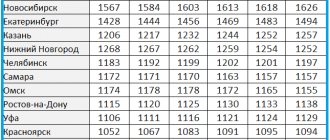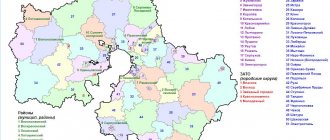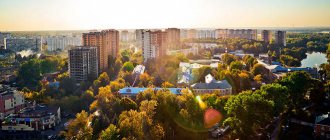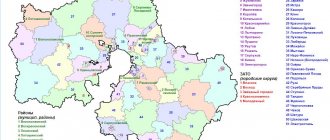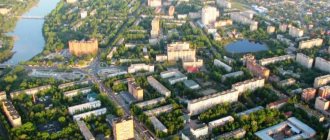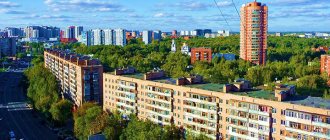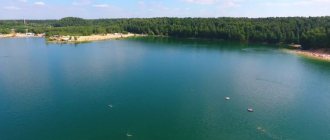In the capital of the Russian Federation there are 12 districts, which unite 125 districts and 21 settlements. One administrative district is one municipal district. The largest district in terms of population is Maryino (254,142 people), and the most sparsely populated is the Molzhaninovsky district, where only 12,264 people live. The largest area in terms of area is Metrogorodok, which also includes part of Losiny Ostrov. It is followed by Yuzhnoye Butovo, Yasenevo, Molzhaninovsky district, Ramenki. The smallest districts are Arbat, Marfino, Savelevsky, Vostochny, Altufevsky districts.
Western administrative district
One of the most attractive administrative entities for life, where transport infrastructure and conditions are constantly improving. Several years ago, three metro stations were opened here - Ramenki, Lomonosovsky Prospekt and Minskaya, and other stations were also launched. Major highways pass through the JSC - Michurinsky and Kutuzovsky Avenues.
The real estate market is improving, the number of new residential properties is growing, especially in the business segment. Many housing options are offered on the secondary market. Due to demand, prices began to rise. The average cost of 1 square meter is about 199 thousand rubles. For an apartment near the metro in a new residential complex you can pay from 6 million rubles.
Odintsovo and Odintsovo district
This city (and its suburbs) has been considered the most comfortable place to live in the Moscow region for several years in a row.
In total, 140 thousand people live in Odintsovo. From Moscow to the city it is only 12 km or 15 minutes by car. Transport connections with the capital are provided by the Minskoye and Mozhaiskoye highways (together with a paid backup), as well as the railway, along which electric trains regularly run to the Belorussky railway station in the center of the capital.
This arrangement allows for an interesting balance to be found for all family members: adults can travel to Moscow to work every day, while their children are quietly in the suburbs.
Although, of course, the city of Odintsovo (and its suburbs and villages) received first place in the ranking not only for transport accessibility.
Odintsovo district is also the leader in ecology among all districts of the near Moscow region (up to 20 km from the Moscow Ring Road). Local authorities are actively engaged in development in this direction; they have even created a separate program for the environmental development of the territory called “Odintsovo Ecopolis”.
Southwestern Administrative District
It has a well-thought-out transport infrastructure, so traffic jams rarely occur in the South-Western Administrative District, even during peak hours. The favorable environmental situation and the abundance of park areas attract people who want to rent or buy an apartment here.
New residential complexes are not being built in the South-Western Administrative District, since dense buildings have existed in the area for a long time. Real estate prices are high. For 1 m2 they ask for 206.5 thousand rubles. The minimum cost of apartments in new buildings is almost 4.5 million rubles.
Municipal districts of the Moscow region
In total, there are 36 municipal districts in the Moscow region:
— Volokolamsk with its center in the city of Volokolamsk (index 143600).
- Voskresensky with its center in the city of Voskresensk (index 140200).
— Dmitrovsky with its center in the city of Dmitrov (index 141800).
— Zaraisky with its center in the city of Zaraysk (index 140600).
— Yegoryevsky with its center in the city of Yegoryevsk (index 140300).
— Istra with its center in the city of Istra (index 143500).
— Klinsky with its center in the city of Klin (index 141600).
— Kashirsky with its center in the city of Kashira (index 142903).
- Krasnogorsk with its center in the city of Krasnogorsk (index 143404).
- Kolomensky with its center in the city of Kolomna (index 140407).
- Leninsky with its center in the city of Vidnoye, Leninsky district (index 142700).
— Lukhovitsky with its center in the city of Lukhovitsy (index 140501).
— Lotoshinsky with its center in the city of Lotoshino, Lotoshinsky district (index 143800).
— Lyubertsy with its center in the city of Lyubertsy (index 140000).
— Mytishchi with its center in the city of Mytishchi (index 141008).
— Mozhaisk with its center in the city of Mozhaisk (index 143200).
— Naro-Fominsk with its center in the city of Naro-Fominsk (index 143300).
— Ozersky with its center in the city of Ozyory (index 140560).
— Odintsovo with its center in the city of Odintsovo (index 143000).
— Noginsky with its center in the city of Noginsk (index 142400).
— Podolsky with its center in the city of Podolsk (index 142100).
— Orekhovo-Zuevo with its center in the city of Orekhovo-Zuevo (index 142600).
— Pavlovsky Posad with its center in the city of Pavlovsky Posad (index 142500).
— Pushkinsky with its center in the city of Pushkino (index 141207).
— Ramenskoye with its center in the city of Ramenskoye (index 140100).
— Sergiev Posad with its center in the city of Sergiev Posad (index 141300).
- Ruzsky with its center in the city of Ruza (index 143100).
— Solnechnogorsk with its center in the city of Solnechnogorsk (index 141500).
— Serpukhovsky with its center in the city of Serpukhov (index 142203).
— Serebryano-Prudsky with its center in the city of Serebryanye Prudy, Serebryano-Prudsky district (index 142970).
- Stupinsky with its center in the city of Stupino (index 142800).
- Taldomsky with its center in the city of Taldom (index 141900).
— Shatura with its center in the city of Shatura (index 140700).
- Chekhovsky with its center in the city of Chekhov (index 142300).
— Shakhovsky with its center in the city of Shakhovskaya, Shakhovsky district (index 143700).
— Shchelkovsky with its center in the city of Shchelkovo (index 141100).
Northwestern Administrative District
The main advantage is excellent transport accessibility. There are metro stations in the districts; the Volokolamsk Highway passes through the district, which became an important transport artery after reconstruction.
In Northwestern Administrative Okrug, about 50% of the territory is occupied by parks and other natural sites, which are considered the cleanest in Moscow. On the real estate market you can purchase new and secondary housing at a price of 185 thousand rubles. for 1 m2. The most affordable housing in the Mitino and Khoroshevo-Mnevniki areas.
RENAMING MOSCOW COURTS
- Babushkinsky District Court of Moscow
- Basmanny District Court of Moscow (formerly Baumansky Court of Moscow)
- Butyrsky District Court of Moscow (formerly Kirovsky Court of Moscow)
- Gagarinsky District Court of Moscow (former Oktyabrsky Court of Moscow)
- Golovinsky District Court of Moscow (formerly Leningradsky Court of Moscow)
- Dorogomilovsky District Court of Moscow (formerly Kyiv Court of Moscow)
- Zamoskvoretsky District Court of Moscow (formerly Moskvoretsky Court of Moscow)
- Zelenogradsky District Court of Moscow
- Zyuzinsky District Court of Moscow (formerly Sevastopol Court of Moscow)
- Izmailovsky District Court of Moscow (formerly Pervomaisky Court of Moscow)
- Koptevsky District Court of Moscow (former Zheleznodorozhny Court of Moscow)
- Kuzminsky District Court of Moscow (formerly Volgograd Court of Moscow)
- Kuntsevsky District Court of Moscow
- Lefortovo District Court of Moscow (formerly Kalininsky Court of Moscow)
- Lyublinsky District Court of Moscow
- Meshchansky District Court of Moscow (formerly Sokolnichesky Court of Moscow)
- Nagatinsky District Court of Moscow (formerly Krasnogvardeisky Court of Moscow)
- Nikulinsky District Court of Moscow (formerly Gagarinsky Court of Moscow)
- Ostankino District Court of Moscow
- Perovsky District Court of Moscow
- Preobrazhensky District Court of Moscow (formerly Kuibyshevsky Court of Moscow)
- Presnensky District Court of Moscow (formerly Krasnopresnensky Court of Moscow)
- Savelovsky District Court of Moscow (formerly Frunzensky Court of Moscow)
- Simonovsky District Court of Moscow (formerly Proletarsky Court of Moscow)
- Solntsevsky District Court of Moscow
- Tagansky District Court of Moscow
- Tverskoy District Court of Moscow (formerly Sverdlovsk Court of Moscow)
- Timiryazevsky District Court of Moscow
- Tushinsky District Court of Moscow
- Khamovnichesky District Court of Moscow (formerly Leninsky Court of Moscow)
- Khoroshevsky District Court of Moscow
- Cheryomushkinsky District Court of Moscow
- Chertanovsky District Court of Moscow (formerly Sovetsky Court of Moscow)
Northern Autonomous Okrug
The environmental situation here is not very favorable, because large industrial enterprises are located in the districts. At the same time, parks occupy only 10% of the total area of the Northern Administrative District.
There are difficulties with transportation. For example, Leningradskoye, Volokolamskoye and Dmitrovskoye highways are busy at any time of the day. The situation was improved by the opening of the metro stations “CSKA”, “Petrovsky Park”, “Okruzhnaya”, “Seligerskaya”, “Verkhnie Likhobory”, “Belomorskaya”.
Northern Administrative Okrug is considered a promising area. City authorities are actively implementing renovation projects. Old houses in the area are being demolished and new residential complexes are being built. The cost of 1 m2 is 178.7 thousand rubles. The minimum price for an apartment in a new building with an area of 11.1 m2 (studio) costs 3.1 million rubles.
Protected areas of the Moscow region
Some parts of the region are under protection. Thus, in the Serpukhov region there is the Prioksko-Terrasny Biosphere Reserve. The bison and communities of the northernmost steppe formations of the European part of the country are protected there. Another important protected site is the Zavidovo National Park, part of which already belongs to the Tver region. Other protected objects are: the Botanical Garden of Medicinal Plants, a natural monument called “Lake Kiev”, and the Yablokov Arboretum.
In total, there are more than 200 specially protected natural areas in the region. To improve the quality of nature conservation, a regional Red Book has been published since 1998.
North-Eastern Administrative District
Similar to the previous area, especially with regard to the transport situation. Yaroslavskoe, Altufevskoe and Dmitrovskoe highways are very busy. But the situation is improving due to the introduction of new metro stations on the Lyublinsko-Dmitrievskaya line.
Unlike the Northern Administrative District, the environmental situation in this district is much better. Industrial centers are adjacent to large parks and Losiny Ostrov.
The disadvantages include the slow development of the real estate market. The main choice of apartments is on the secondary market. Developers in the residential complex offer apartments. The cost of 1 m2 starts from 161.2 thousand rubles. In new buildings, housing prices start from 2.5 million - 3 million rubles.
How to use it correctly?
- Mikhailovo-Yartsevskoe.
- Nefedorovskoe.
- Pervomayskoe.
- Troitsk
- Shapovskoe.
- Krasnopakharskoe.
- Voronovskoe.
- Klenovskoe.
- Rogovskoe.
- Kyiv.
Composition of Moscow
Expansion of Moscow in 2022
The Naro-Fominisky municipal district (New Moscow) also includes a number of urban (Kyiv and Kokoshino) as well as rural settlements of Pervomaiskoye, Novofedrovoskoye and Murashkinskoye.
The city is expanding, rural and urban settlements are being absorbed. The latest “preys” of the capital include Shcherbinka, Troitsk, Moskovsky and Zelenograd. Previously, these cities were separate territorial units, but today they are part of the capital.
Southern Administrative District
Construction work is ongoing constantly, which is why the Southern Administrative District is considered the most developed in the capital. The transport infrastructure, as well as the situation, are far from ideal. The busiest roads in Moscow pass through here. The Technopark metro station was recently opened.
The price for 1 m2 of housing is 161.7 thousand rubles. It is quite expensive, considering the proximity of the Moscow Ring Road. Inexpensive apartments and apartments in new buildings can be purchased in Biryulyovo East for 2.1 million rubles.
Anti-rating or outsider cities
Despite the obvious progress in the development of many districts of the Moscow region in recent years (and the relatively rosy picture of the state of affairs), it is impossible not to note some negative aspects.
In addition to the leading cities, there is also a so-called “Red” rating zone. It includes municipal and urban entities in which, recently, there has been a deterioration in the standard of living of the population.
According to the Moscow Region Government for 2022, the red part of the rating includes:
- Zvenigorod;
- Shatura;
- Chekhov;
- Ivanteevka;
- Volokolamsk;
- Korolev;
- Khimki;
- Dzerzhinsky;
- Losino-Petrovsky and several other smaller towns.
Main problems: ecology, lack of infrastructure and transport accessibility.
This, of course, does not mean that it is not worth buying real estate in these cities and their suburbs. As we already wrote above, the quality of life rating is more a subjective than an objective indicator. But, other things being equal (for example, price), it is recommended to pay attention to the leaders in the rating.
Let us note that the Moscow region government, in recent years, has begun to pay much more attention to improving the quality of life of residents of the Moscow region, and to allocate more funds from the budget for this. In particular, regional programs aimed at improving the environment and social infrastructure are being actively implemented.
South-Eastern Administrative District
The district is called the most affordable in terms of purchasing housing, but depressed due to the lack of prospects. In the South-Eastern Administrative District, a third of the territory is occupied by industrial zones, metallurgical and chemical plants are concentrated. Because of this, there is an unfavorable environmental situation here, which has a positive effect on the cost of housing.
The price of 1 m2 is 151.7 thousand rubles; in new buildings, one-room apartments cost from 3 million rubles.
The district is undergoing active development and developing transport infrastructure. A few months ago, metro stations were opened on the Nekrasovskaya line.
Improvement of the territory of the Moscow region
Territory improvement work is focused primarily on improving the condition of the courtyards of multi-storey buildings. For this purpose there is a special law “On improvement in the Moscow region”. When implementing it, methodological recommendations are used for organizing comprehensive landscaping of courtyard areas. This is the responsibility of the administration of the corresponding urban settlement.
The courtyard area is understood as land directly adjacent to apartment buildings and in common use. It may include a playground, parking, waste storage area, green space, lights, posters and other public facilities.
Comprehensive landscaping of the territory means bringing all the components of the territory described above to a standard state.
Activities to provide all these attributes and maintain them in proper condition are carried out annually. The greatest complaints are caused by the insufficient level of lighting in the areas and the dilapidation of children's playgrounds. There are also considerable problems with the condition of the road surface of internal and external roads.
Active work on comprehensive improvement was carried out in 2016. They included asphalting roads and paths, overhauling playgrounds, installing additional play elements, repairing fences, and installing information stands.
Eastern administrative district
Considered the worst option for living in Moscow. The large industrial zone “Kaloshino”, Entuziastov Highway and Shchelkovskoe Highway, which are constantly busy, are concentrated here. Even the appearance last year of the Lukhmanovskaya and Ulitsa Dmitrievskogo metro stations did not improve the situation.
The real estate is represented by brick houses that were built in the 1950s – 1970s. In the primary market, mainly comfort-class housing is built. The cost of 1 m2 is 166.8 thousand rubles. A studio with an area of up to 20 m2 near the metro will cost from 5 million rubles.
Nature
The region is located predominantly on the plain. In the western part it is hilly and elevated, and in the eastern part it is flat and lowland.
The climate is moderate continental, with well-defined seasons, including transitional ones. Summers are warm and winters are moderately cold. In the east of the region, winters are colder and summers are hotter. The average annual precipitation is 713 mm.
The river network belongs to the Volga River basin.
The vegetation is represented by forests and meadows. In the north, coniferous spruce forests predominate, in the south – coniferous-broad-leaved, deciduous forests.
Central Administrative District
It has a convenient location on the map of Moscow and developed infrastructure, but this does not solve transport and environmental problems. The Central Administrative District has a huge number of historical buildings that were built in the 19th – 20th centuries. Housing in the budget segment is not being built because it is not profitable. Land prices are very high.
The main buyers are wealthy buyers who want and can live in the center, so they buy premium housing. Prices for 1m2 start from 320 thousand rubles. Buyers are offered apartments and studios, which will cost from 4.2 million rubles.
Factors for selecting rating leaders
When choosing housing for your family, especially with children, it is important to find a compromise between the following parameters:
- Attractive prices for a house or apartment with enough space for comfortable living for all family members;
- Distance from home to work;
- Availability of school and preschool institutions nearby;
- Good ecology;
- Safe living environment;
- Availability of medical facilities nearby;
- Availability of shops, pharmacies, bank branches, etc.
Rating of the best areas to live in Moscow
Many areas are promising in terms of investment and infrastructure development. When choosing a place to live and an area to buy real estate, you need to take into account many factors. Among them, environmental friendliness, transport accessibility, green areas, social facilities and infrastructure development occupy an important place. The rating includes areas where Moscow residents will be able to purchase an apartment at a price of up to 20 million rubles.
Ramenki in JSC
It is considered one of the most environmentally friendly areas of Moscow, since about 25% of the territory is occupied by green spaces. This is the forest park area of the Sparrow Hills and the Botanical Garden.
Other benefits:
- Lack of industrial enterprises.
- A large number of universities, including Moscow State University, the All-Russian Academy of Foreign Trade.
- Developed sports, recreational and cultural infrastructure.
- Transport accessibility improved after the commissioning of the Michurinsky Prospekt, Ramenki, and Lomonosovsky Prospekt metro stations.
But there are also certain disadvantages. First of all, these are high housing prices. The average cost of a 3-room apartment on the secondary market is 20 million rubles. In addition, high demand and competition do not allow prices to be reduced.
Dorogomilovo in JSC
In second place is another district of the Western Administrative District, which is located around. Main advantages:
- High level of transport accessibility. Kutuzovsky Prospekt runs through almost the entire district, and there are metro and MCC stations.
- Close location to Moscow-Ruka.
- Victory Park is located nearby.
- High-quality infrastructure - large shopping centers.
- Housing is represented mainly by Stalinist buildings and brick houses.
- Good schools and other educational institutions.
In Dorogomilovo, as in Ramenki, housing prices are high. An apartment on the secondary market costs up to 20 million rubles. Major transport routes pass close to residential areas. Experts believe that the area is not the safest in Moscow due to its proximity to Kutuzovsky Prospect, where the former party elite lives. Their homes are constant targets of theft.
Khoroshevo-Mnevniki in Northwestern Administrative District
The area contains extensive natural areas. Among them, the largest is the Serebryany Bor park, which occupies a third of the territory of Khoroshevo-Mnevniki. Social, transport and residential infrastructure has long been established here. It is convenient to travel by car and public transport to the center of the capital and beyond. Near the borders of the district there are the Polezhaevskaya and Oktyabrskoye Pole metro stations, as well as the Zorge and Khoroshevo MCC stations.
Among the disadvantages, it is worth noting the remoteness of metro stations, although they promise to build new ones soon, as well as the high cost of housing, given the distance from the city center. But the high prices are justified by the proximity of Serebryany Bor and the spacious beach area.
Filevsky Park in ZAO
Living here has almost the same advantages:
- Close location to the center of Moscow.
- Infrastructure development.
- Low level of residential density.
- Spacious recreational area. Filevsky Park is also located here.
- Educational institutions are among the TOP best in the capital.
Again, among the disadvantages, experts note inflated housing prices. And this despite the fact that the Khrunichev plant is located nearby, next to which a large residential development is planned.
Danilovsky in the Southern Administrative District
It is located near the center of Moscow and has a low population density per square meter, especially compared to the neighboring Yuzhnoportov district. Main advantages:
- Excellent transport accessibility.
- There are three metro stations in the area - “Technopark”, “Auto” and 2 MCC stations “ZIL” and “Avtozavodskaya”.
- The Moscow River flows through the territory.
- After the transformation of the ZIL industrial zone, modern residential complexes began to appear in the area and infrastructure began to develop.
The Danilovsky district does not have the best ecology, since there are not enough green areas and large parks.
OLYMPUS DIGITAL CAMERA
Strogino in Northwestern Administrative District
An ecologically clean and green area of the capital, which is preferred by married couples with children. About 50% of the district's territory is occupied by the Stroginskaya floodplain and forested areas. A river flows through Strogino, creating backwaters and a beach area. There are many sports and water facilities in the area where you can relax at any time of the year.
Strogino is provided with excellent social and commercial infrastructure, residential buildings and a metro. In the very center of the area there is a metro station of the same name. The cost of apartments has always been low and this trend continues to this day.
Residents of Strogino believe that the disadvantages of living here include the distance from the capital center, the proximity of the Moscow Ring Road, the presence of one metro station,
Krylatskoye in JSC
Lovers of nature and silence prefer to settle in the area. More than half of the territory of Krylatskoye is occupied by park and forest areas. Advantages:
- Well developed infrastructure.
- An excellent selection of private and public schools and kindergartens.
- Sports facilities - indoor cycling track, Rowing Canal, cycling track, ski slopes, school for those who want to learn skiing.
There is only one metro station in the Krylatskoye district. People living on the outskirts of the area have difficulty getting to other parts of the city. At the same time, there are not the most budget prices for housing, as well as for food in local supermarkets and shops. This is due to the proximity of Rublevskoye Highway, near which there are many elite villages.
Territorial division of Moscow
There are 12 administrative districts in Moscow:
- Central administrative district.
- Western administrative district.
- Northwestern Administrative District.
- Northern administrative district.
- North-Eastern Administrative District.
- Eastern administrative district.
- South-Eastern administrative district.
- Southern administrative district.
- Southwestern administrative district.
- Novomoskovsk administrative district.
- Trinity administrative district.
Muscovites often determine their approximate location by the cardinal direction, which is associated with the names of the districts. For example: “Where are you? In North-west!"
Below in the diagram you can see the location of the districts.
Map of Moscow with administrative districts
Each of the districts includes districts, of which there are 125 in the city! In 2012, there was a major expansion of the city, resulting in the creation of two new districts, as well as a new administrative unit - settlements. Settlements are “new areas” that were previously small cities or towns, but when the city expanded, they became part of Moscow. There are currently 21 such settlements in Moscow.
Most counties have over a million people. And in total, according to official data, as of January 1, 2019, 12,659,279 people live in all districts of Moscow. Of course, the real number of people actually living is higher, since many live without temporary registration.
